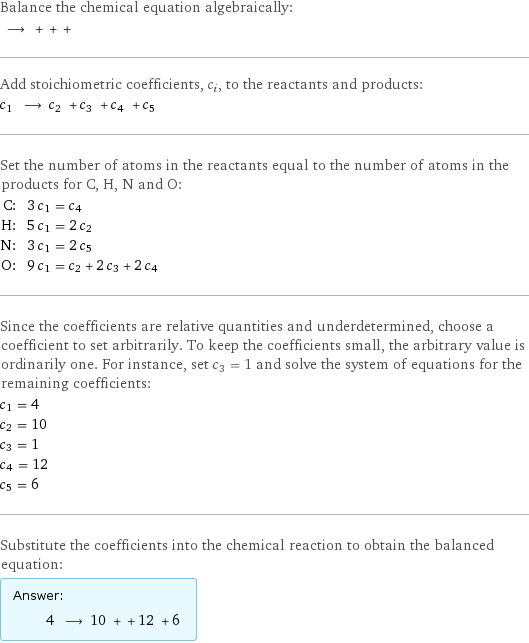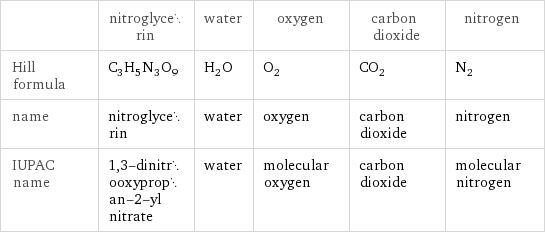Input interpretation

nitroglycerin ⟶ water + oxygen + carbon dioxide + nitrogen
Balanced equation

Balance the chemical equation algebraically: ⟶ + + + Add stoichiometric coefficients, c_i, to the reactants and products: c_1 ⟶ c_2 + c_3 + c_4 + c_5 Set the number of atoms in the reactants equal to the number of atoms in the products for C, H, N and O: C: | 3 c_1 = c_4 H: | 5 c_1 = 2 c_2 N: | 3 c_1 = 2 c_5 O: | 9 c_1 = c_2 + 2 c_3 + 2 c_4 Since the coefficients are relative quantities and underdetermined, choose a coefficient to set arbitrarily. To keep the coefficients small, the arbitrary value is ordinarily one. For instance, set c_3 = 1 and solve the system of equations for the remaining coefficients: c_1 = 4 c_2 = 10 c_3 = 1 c_4 = 12 c_5 = 6 Substitute the coefficients into the chemical reaction to obtain the balanced equation: Answer: | | 4 ⟶ 10 + + 12 + 6
Structures

⟶ + + +
Names

nitroglycerin ⟶ water + oxygen + carbon dioxide + nitrogen
Reaction thermodynamics
Enthalpy

| nitroglycerin | water | oxygen | carbon dioxide | nitrogen molecular enthalpy | -370.9 kJ/mol | -285.8 kJ/mol | 0 kJ/mol | -393.5 kJ/mol | 0 kJ/mol total enthalpy | -1484 kJ/mol | -2858 kJ/mol | 0 kJ/mol | -4722 kJ/mol | 0 kJ/mol | H_initial = -1484 kJ/mol | H_final = -7580 kJ/mol | | | ΔH_rxn^0 | -7580 kJ/mol - -1484 kJ/mol = -6097 kJ/mol (exothermic) | | | |
Chemical names and formulas

| nitroglycerin | water | oxygen | carbon dioxide | nitrogen Hill formula | C_3H_5N_3O_9 | H_2O | O_2 | CO_2 | N_2 name | nitroglycerin | water | oxygen | carbon dioxide | nitrogen IUPAC name | 1, 3-dinitrooxypropan-2-yl nitrate | water | molecular oxygen | carbon dioxide | molecular nitrogen